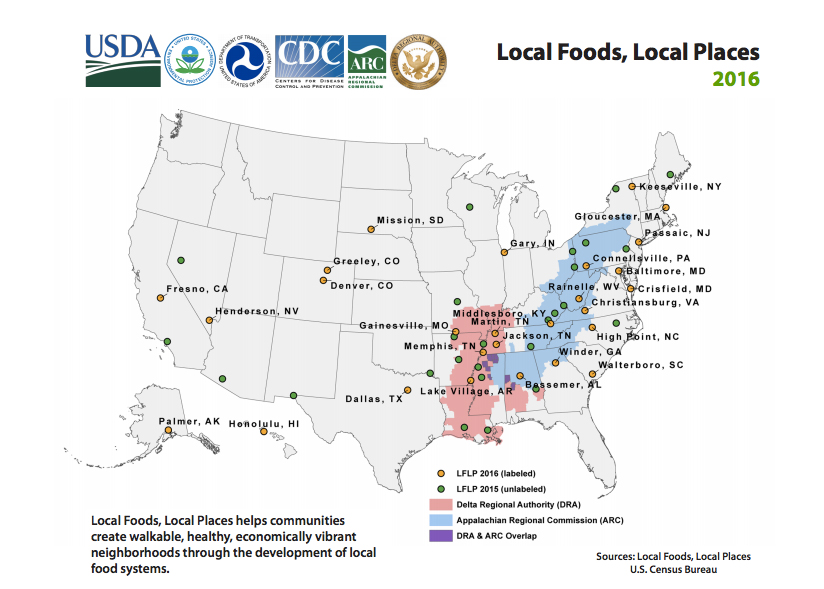
The United States farm sector has been steadily shrinking for years. According to the 2012 Census of Agriculture the farming population shrunk by 4 percent between 2007 and 2012, while new farmers (farming for 5 years or less) declined by as much as 23.3 percent. And as the farmers go, so goes farmland; recent estimates project that we are losing 3,000 acres of productive farmland per day to development sprawl alone. The effect of this loss is sometimes difficult for consumers to feel because food is still being produced, increasingly by mega-farms, even while the more traditional farms we associate with that food disappear and farming opportunities decline.
Fortunately, demand for local food and farm businesses has taken a sharp upturn in recent years; by some estimates there is now billions of dollars of demand for local and regional food. High levels of consumer demand, combined with increased interest in and awareness around our food systems, has triggered major investments from both the public and the private sector. As part of an ongoing effort by the federal government to reenergize the local food and farm sector, the Obama Administration recently announced their second round of awards through the Local Foods, Local Places initiative.
On January 25, 2016 the Administration announced technical assistance awards would be made to 27 urban and rural communities across 22 U.S. states. Awardees are given support for a wide variety of projects dedicated to boosting economic opportunities for local farmers and businesses, improving access to healthy local food, and promoting childhood wellness. Samples of projects from this year’s awardees include:
Arkansas
- Lake Village, Arkansas, will grow the city’s community garden, expand worksite wellness programing for local businesses, and connect its parks with new trail systems to improve local food access, promote active living, and stimulate economic development.
Hawaii
- The Hawaii Community Development Authority in Honolulu, Hawaii, plans to identify food-based projects that will spur greater investment and stewardship in the Kakaako Makai community, improve returns on local food production, integrate food security initiatives with community and transit-oriented development planning, and reduce stormwater runoff and vulnerability to sea level rise.
West Virginia
- The Greenbrier Valley Economic Development Corporation in Rainelle, West Virginia, will receive technical assistance to establish a mentor program for farmers and producers, develop a community grocery store, form a food alliance, and put vacant land into productive use. (For a full list of 2016 awardees and projects click here)
To date, the Local Foods, Local Places initiative has supported food and farm based economic development projects in 53 communities across 24 states, with a focus on sites in the Appalachian Regional Commission and Delta Regional Authority areas.
Technical assistance to help stir investments like this can go a long way for local farmers. In 2014, economists from Penn State’s College of Agricultural Sciences found that for every $1 increase in agricultural sales, personal income rose by 22 cents over the course of five years.
“There [had] been a lot of hope, but little evidence, that local food systems [could] be an engine of economic growth in communities,” said Stephan Goetz, professor of agricultural and regional economics in Penn State’s College of Agricultural Sciences and director of the Northeast Regional Center for Rural Development. “Our findings show that, at least in certain regions of the country, community-focused agriculture has had a measurable effect on economic growth.”
So far applications for the Local Food, Local Places initiative have dramatically outstripped awards (this year 27 awards were made out of 300 applicants), suggesting high demand and need for increased investment in food and farm development initiatives going forward.
The economic development initiative was developed in 2014 in partnership with the White House Rural Council, the U.S. Department of Agriculture, Environmental Protection Agency, Department of Transportation, the Appalachian Regional Commission, the Delta Regional Authority, and the Centers for Disease Control and Prevention.
For more on USDA programs supporting local and regional food systems, see these pages in the NSAC Grassroots Guide to Federal Farm and Food Programs.


In June 2013 I purchased a very small meat processing plant in Batesville, AR. We are fully USDA inspected and do custom butchering for customers as well as purchasing for ourselves. We have customers that bring their livestock to us for processing to sell at local markets, restaurants or retail outlets. I am looking for ways to help grow my business by purchasing more beef and pork from local farmers to support the local food/farm to table movement. (We already purchase cattle from local farmers to process into ground beef which we sell in our retail/wholesale meat market.) This will also stimulate economic growth by supporting the local farmer and keep the money here locally instead of buying from out of state suppliers. Now more than in the past few years people are wanting to know where their food is coming from and how it was raised. By purchasing locally I can provide that info and support local farmers.
I was wondering if there is any money out there to help the small business owner in this endeavor. Any information you can give me will be greatly appreciated.
Thank you for your time.
Sincerely,
Diane Runsick
Hi Diane,
I’m sorry we missed your comment. We would be happy to try and help point you toward the right agency that can address your questions. Please shoot us an email at info@sustainableagriculture.net for follow up.